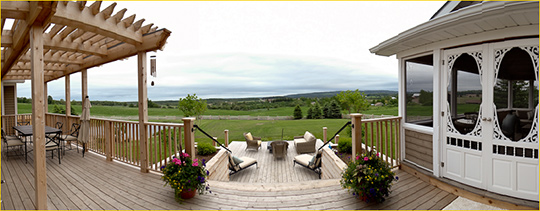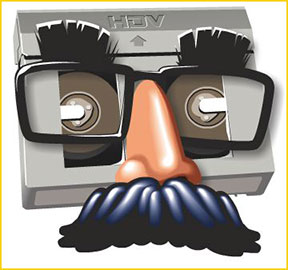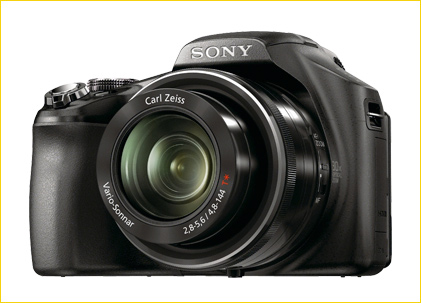
There is a class of cameras popularly called “Superzooms“. These are fixed lens cameras with small sensors and very broad zoom ranges. At the long end their reach goes out to between 600mm and 800+mm. And therein lies their appeal. In a size about the same as an entry-level DSLR one gets a camera with a focal range of between 27 – 810mm (in the case of the new Sony HX-100V). One also gets video capability and, typically, a wide range of speciality features. Oh yes – and all of this for a price under about $500.
But There’s a Catch
So –What’s the catch?, you might ask. Simple – the sensor is very small; typically a 1/2.3″ CMOS device measuring 4.55 X 6.17mm. Compared to a Four Thirds sensor at 13 X 17.3mm, or an APS-C at about 15.5 X 23.4mm, let alone full frame at 24 X 36mm, this is really mini-ville. Just as with most pocket cameras.
Of course the reason that cameras like this can have 30X zoom lenses is exactly because their sensors are so small. A DSLR with a 27 – 810mm zoom would weight about 20lbs and need two men to carry about.
The downside of the “catch” then is image quality. Small sensors mean small photo sites, which in turn means more noise. This is especially true, since for the most part manufacturers still haven’t gotten the memo that as far as serious amateur photographers are concerned the megapixel wars are over. (We don’t want more pixels – we want better pixels!)
Technology has its way though, and sensor makers (such as Sony, who manufactures many of the sensors used by themselves as well as other camera makers) are discovering ways to make sensels more sensitive and less noisy. The sensor used in the HX-100V is a case in point. It features Sony’s newback-illuminatedExmor R CMOS sensor. This manufacturing technique moves the internal wiring from the front to the back of the sensor, where it blocks light, to the rear, allowing for greater sensitivity and thus lower noise.
As we will see, this new sensor technology has allowed Sony to produce a camera (the HX-100V) with a 1/2.3″ sensor that produces quite clean images at higher ISOs than we’ve seen before from cameras of this type.
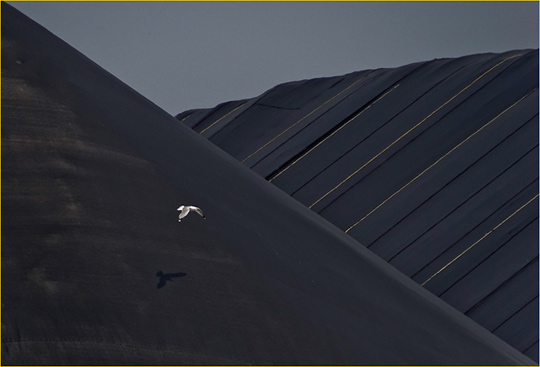
Cruising The Waterfront. Toronto, June, 2011
Sony HX-100V @ ISO 100. 1/640 sec @ f/5.6. 117mm (650mm EQ)
One additional thought on this topic. Because the sensels in small high count sensors are smaller, any noise that they have is more finely spaced. This means that though noise may be visible at 100% on-screen, in prints and at normal sizes online, this noise is much less visible.
Also, these cameras do a lot of processing at the pixel level before recording the in-camera JPG. For this reason 100% on-screen pixel peepingis just not the way to judge image quality. It will tell you little to nothing about how your images will look in a print. Having said that (as Seinfield would say), overall image quality from the HX-100V is still a compromise compared to that from larger sensor cameras.
The Competition
The Superzoom is a popular camera catagory, with almost all of the major players participating. In October, 2010 I looked at contenders from Canon and Fuji in a piece entitledA Superzoom Shootout.
With more than a half year between then and now, it isn’t possible for me to directly compare the Sony HX-100V with either the Canon SX30 or the Panasonic FZ100. The Panasonic was the winner of last year’s battle, but I think that given some of the strengths of the new Sony in might be a closer race this time.
LCD and EVF
The rear LCD on the HX-100V is articulated (vertical axis only) and of very high resolution, with 921k dots. The camera also has an electronic viewfinder, though it’s of much lower resolution. Still, for photographers like me that prefer shooting with a camera to the eye, it’s a welcome addition.
There is an eye detection capability, so that the camera switches automatically when brought to eye level, but the detection setting is too slow, and sometimes I find myself looking trhough a blank finder, wondering what’s wrong. Then, a moment later, the image appears.
This can be prevented by manually setting either LCD or EVF viewing via a top-mounted button.
Zoom Control
Zooming is via the usual finger ring surrounding the shutter release. But I was pleased to note that zooming can also be affected by a ring surrounding the lens barrel. The control is fly-by-wire, but it feel much more natural to me to zoom this way, and so I use it in preference to the release-surround lever.
This ring can also be turned into a focusing ring – againfly by wire– but as with all such system it is much less successful in this role. Without a focusing aid, such as “Peaking”, it’s almost impossible to achieve critical focus, even when using the magnify mode available via to the top-mountedFocusbutton.
Modes
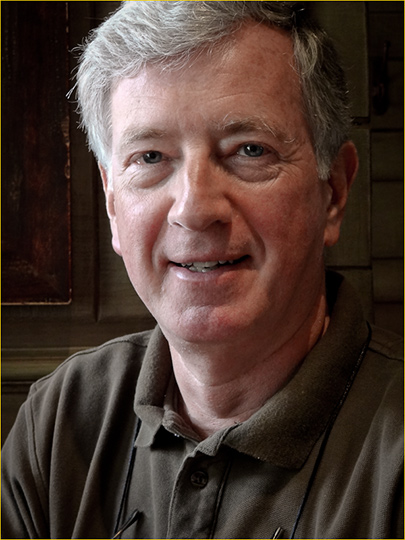
Harvey S. Toronto, June, 2011
Sony HX-100V @ ISO 800. Superior Auto.
Sitting in a dimly lit restaurant with my friend Harvey S. I wanted to take a casual portrait. I had previously been working in manual mode, and didn’t want to take the time to re-adjust the camera. I quickly set the camera toSuperior Auto Mode(don’t you love these names?) and hit the shutter release.
The camera took a number of frames in rapid succession (who knows how many?) and the results appears above. The colour was way too saturated, (fixed in Lightroom) but other than that not bad for a slowish lens at ISO 800. A bit “crunchy” at 100% on screen, but absolutely fine on an 11X17″ print.
All cameras have aProgrammode, which sets exposure basics. Most have anAutomode in which the camera analyses the scene and uses whatever pre-sets it may have (Pet, Snow, Fireworks) so as to adjust the camera most appropriately.
The HX-100V hasSuperior Auto Mode also activates whichever special mode it thinks might be needed, such as the one that takes multiple images and blends them for lower noise high ISO shooting. I must say that this works pretty well, and will appeal to the less experienced photographer and allow them to take technically better photographs than they otherwise might.
Panoramas & Macros
Country Porch Vista. Clearview, Ontario. June, 2011
Sony HX-100V @ ISO 100.
Sony invented the Sweep Panorama mode. Simply orient the camera the way that you want and then do a quick pan. With the HX-100V the camera can be set to create a 42.9 Megapixel panoramic images with 10480 X 4096 resolution. That’s large enough to make about a 12″ X 30″ print at 300ppi.
How will it look? Not that bad actually, even at that size. Mainly though because large prints are typically viewed at a larger distance than small ones. This means that the artifacts that the camera produces when shoot a sweep panorama won’t be all that visible, just as they aren’t on smaller prints. It’s only at 100% on-screen pixel peeping that the image disappoints. Not in prints, and not when viewed by a non-critical viewer.
Regrettably, the camera will only shoot Sweep Panoramics with the lens at its widest focal length. Sony’s more advanced (expensive) cameras can do so at any focal length.
Macro shooting is similarly restricted to the len’s shortest focal length. Still, handy for casual things like flower and ant photographs
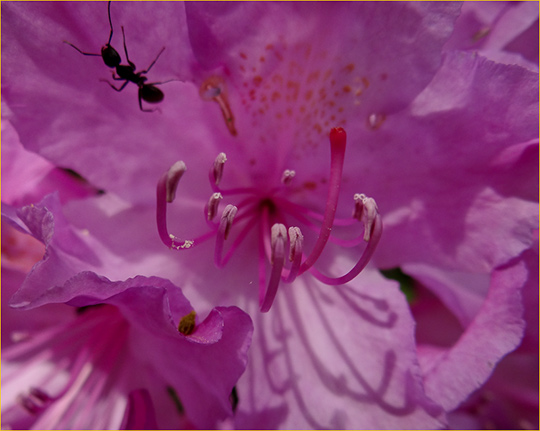
Macro Example
Sony HX-100V @ ISO 100. 4.8mm focal length.
Battery and Manual
Time to vent a little.
The NP-FH50 battery for the HX-100V is one of the company’s standard video camera batteries. That’s the good news. The bad news is that the camera does not ship with a stand-alone charger, but rather with a charger that only works via the camera. This means that you can’t charge the battery and use the camera at the same time. Also, the charger is bulky, and has a wire coming out of it to the camera and also another to plug into the wall. Altogether bulky and awkward.
Why? What’s wrong with a simple wall-pack charger that plugs directly into the wall? They can be purchased at retail for about $5.00 from online sellers on Amazon and Ebay, so imagine how little they must cost to manufacture.
The other gripe is that like so many cameras these days the HX-100V does not come with a printed manual. There’s a pamphlet in 7 languages that explains how to put in the battery and the card, and how to set automatic mode. Thanks.
But with cameras as complex and sophisticated as the HX-100V a real manual is an absolute necessity. Sure, there is a CD with a PDF manual included, but this is no substitute for a small printed manual that can be put in ones pocket or bag.
I am reminded of a story told to me by a friend (not a serious photographer) a few months ago. He had bought a new camera at an airport store to shoot with on his trip to Europe. But he discovered that there was no manual, and the camera completely baffled him for the next two weeks. He wasn’t traveling with a laptop computer and so the online or CD manual was unavailable to him.
How much can it cost to print a manual? How much does it cost to include a wall pack charger. A total of $3?
Sadly Sony isn’t the only guilty party on this fiasco. Just about every camera company is similarly at fault.Fail!
3D
I have nothing to write about this camera’s 3D capability. I believe that just as in the 1950’s when 3D was a fad, this time too it will eventually pass the scene. I recently bought a new TV and deliberately decided not to get a 3D version, though the salesman pushed hard. Not because it cost $1000 more in the size that I wanted, but because I find watching 3D movies to be a fun but ultimately a gimmiky way to be entertained. Wearing glass to watch TV (or look at stills on a screen) is simply not my idea of a good time.
So, if you want to learn more about this camera’s 3D capabilities I’m afraid that you’ll have to read some other review.
Stabilization
When you have a lens that can reach out to 810mm equivalent you’d better have good stabilization. Fortunately the HX-100V, as do almost all Sony cameras, has excellent lens-based IS. Indeed, as seen below, when shooting video the HX-100V implements the company’s excellent Active Image Stabilization,which makes even hand-held shots at 800mm look good. It’s almost uncannily good.
Video
In addition to its pack-leading Supersoom stills capability the HX-100V shoots Full HD (1080P) video at up to 60 fps. Yes, 1080P60. And, it does it in AVCHD at 24Mpbs. These are impressive specs, and so is the video quality.
The spanner in the works (you knew that there would be one – right) is that video is recorded in fully automatic mode only. Yes, Scene Modes are available, but otherwise the only control available is exposure compensation. Zooming while shooting is possible, but lens noise will be picked up.
The stellar feature when combined with the camera’s very long reach is Sony’sActive Image Stabilization. We’ve seen this on Sony video cameras, but to my knowldge this is the first time it’s shown up on a Superzoom. It is most impressive, as you can see from the brief linked video below.
The Clips of The Brief Video Sample
Were Both Shot Hand-Held at 810mm
The combination of 1080P60 and 24 Mbps makes the HX-100V capable of producing some very fine video But there’s a smallgottcha. Like thePanasonic T700 video camera, which was the first to offer 60P, the files from the Sony are not supported by most editing programs.
The least expensive solution for Windows users is Nero Vision, which I am told can handle these files.Sony Vegas Pro for Windows lets you render in Mainconcept AVC/AAC. I am told thatAdobe Premiere Pro CS5can also handle AVCHD files at 1080P/60. Edius Neo 2 BoosterandEdius 5.5will also edit the 1080 60p files on a decent computer.
Mac users withFinal CutoriMoviewill need to transcode the files to a format better suited to non-linear editing. Roxio Toast 10 Titanium (PC and Mac) can also convert files to a robust transcoding format, such as Prores.
ClipWrap
Probably the easiest way for Mac users to deal with the HX-100V’s special 1080/60P files is to use a program called Clipwrap. This program costs US $49.95. It’s what I use.
Why Not Raw?
When a camera maker fails to include raw capability in a camera it makes me wonder why? No camerashootsin JPG format. To create a JPG it has to take the raw image and turn it into a JPG. On these cameras the raw data is then simply thrown away.
I suppose that there is a bit of work to actually write the raw data as a proper file, but come on! Can it be that tough? Just adopt the DNG format and you don’t even have to create version 93b of your proprietary raw software.
The answer to this conundrum though likely lies in the fact that increasingly camera makers are fixing optical aberations in firmware, rather than in glass. Nothing wrong with this, but it means that only by producing in-camera JPGs can these corrections be applied without the photographer being aware of them.
Let’s Get Real
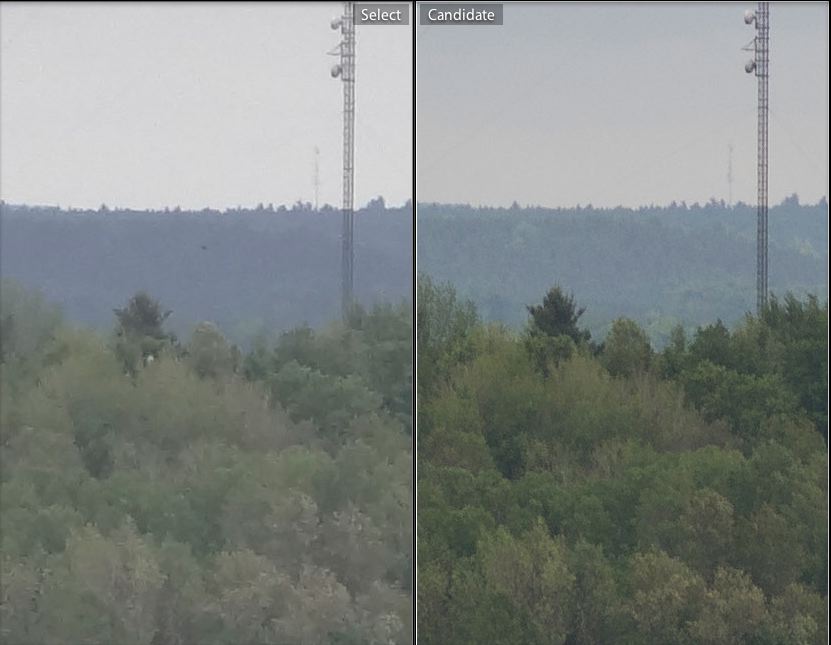
Sony HX-100V / Olympus E-PL2
As much as I find a lot to like in the HX-100V, in the end it still is a small sensor camera – no different in terms of image quality to legions of cameras with small 1/2.3″ sensors. Yes, this new generation of backlit CMOS sensors is better than what’s come before, especially at higher ISOs. But, even at base ISO these tiny sensors can turn fine detail intowatercolour mush –sometimes even when seen on moderate sized prints, let alone at 100%.
Above is a 100% crops of two images, the one of the left shot with the HX-100V, and the one on the right with a consumer grade Micro Four Thirds camera of similar size (though not resolution), the Olympus E-PL2. The Oly is 12MP while the Sony is 16MP. Of course there is no lens that will take the Oly out to 810mm, but at more reasonable focal lengths an MFT camera doesn’t suffer much in terms of size comparison, though it does cost more. In the end little more needs to be written about the difference seen. Bigger sensors trump smaller sensors. It’s simple physics.
For amateur photographers looking for a highly versatile camera, with great video, long reach, and lots of toys, the Sony HX-100V will really satisfy. For the more serious photographer interested in stills image quality as much as video or long reach, my recommendation would be an MFT camera or a Sony NEX.
June, 2011
You May Also Enjoy...
21-24-38VF
A Limited View In early 2001Leicamade available a new multi-focal length wide-angle viewfinder for itsM seriescameras. The viewfinder has three settings; for21mm,24mmand28mmlenses. Such viewfinders are needed
645-MLU
To Lock or Not Since its introduction in 1984 thePentax 645has lacked mirror-lock-up capability. Those that owned them claimed that this was no real
